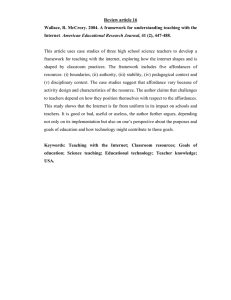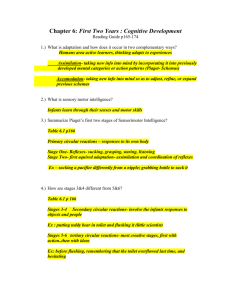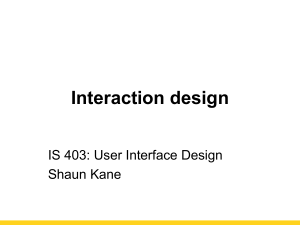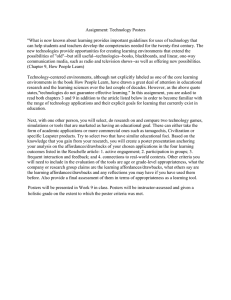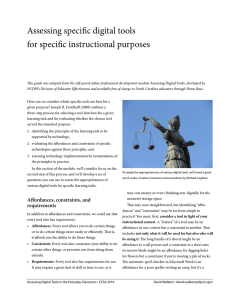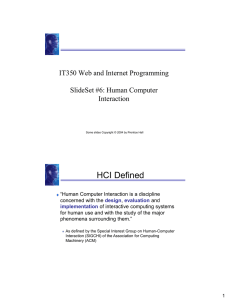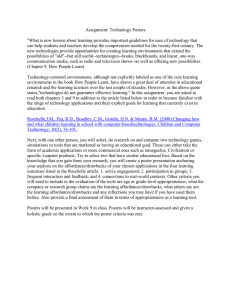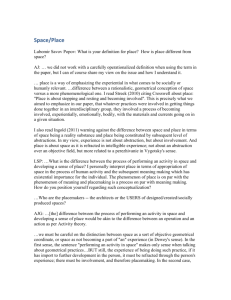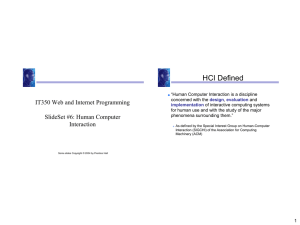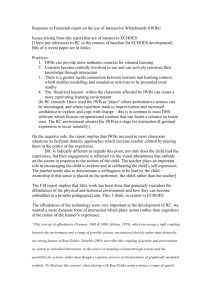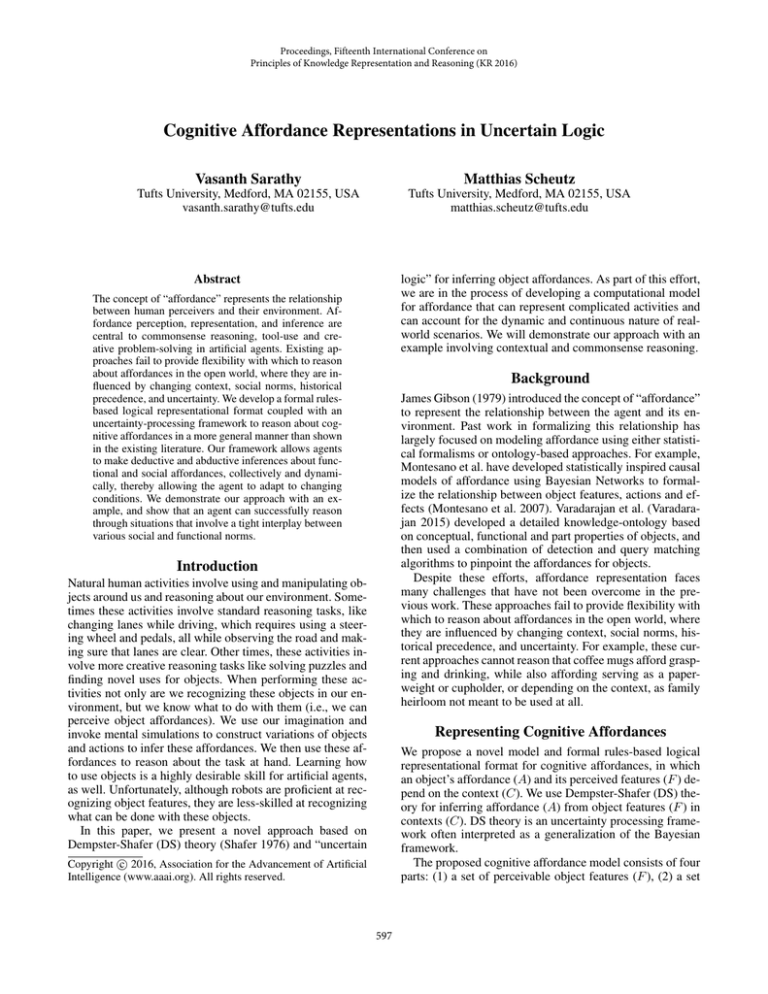
Proceedings, Fifteenth International Conference on
Principles of Knowledge Representation and Reasoning (KR 2016)
Cognitive Affordance Representations in Uncertain Logic
Vasanth Sarathy
Matthias Scheutz
Tufts University, Medford, MA 02155, USA
vasanth.sarathy@tufts.edu
Tufts University, Medford, MA 02155, USA
matthias.scheutz@tufts.edu
logic” for inferring object affordances. As part of this effort,
we are in the process of developing a computational model
for affordance that can represent complicated activities and
can account for the dynamic and continuous nature of realworld scenarios. We will demonstrate our approach with an
example involving contextual and commonsense reasoning.
Abstract
The concept of “affordance” represents the relationship
between human perceivers and their environment. Affordance perception, representation, and inference are
central to commonsense reasoning, tool-use and creative problem-solving in artificial agents. Existing approaches fail to provide flexibility with which to reason
about affordances in the open world, where they are influenced by changing context, social norms, historical
precedence, and uncertainty. We develop a formal rulesbased logical representational format coupled with an
uncertainty-processing framework to reason about cognitive affordances in a more general manner than shown
in the existing literature. Our framework allows agents
to make deductive and abductive inferences about functional and social affordances, collectively and dynamically, thereby allowing the agent to adapt to changing
conditions. We demonstrate our approach with an example, and show that an agent can successfully reason
through situations that involve a tight interplay between
various social and functional norms.
Background
James Gibson (1979) introduced the concept of “affordance”
to represent the relationship between the agent and its environment. Past work in formalizing this relationship has
largely focused on modeling affordance using either statistical formalisms or ontology-based approaches. For example,
Montesano et al. have developed statistically inspired causal
models of affordance using Bayesian Networks to formalize the relationship between object features, actions and effects (Montesano et al. 2007). Varadarajan et al. (Varadarajan 2015) developed a detailed knowledge-ontology based
on conceptual, functional and part properties of objects, and
then used a combination of detection and query matching
algorithms to pinpoint the affordances for objects.
Despite these efforts, affordance representation faces
many challenges that have not been overcome in the previous work. These approaches fail to provide flexibility with
which to reason about affordances in the open world, where
they are influenced by changing context, social norms, historical precedence, and uncertainty. For example, these current approaches cannot reason that coffee mugs afford grasping and drinking, while also affording serving as a paperweight or cupholder, or depending on the context, as family
heirloom not meant to be used at all.
Introduction
Natural human activities involve using and manipulating objects around us and reasoning about our environment. Sometimes these activities involve standard reasoning tasks, like
changing lanes while driving, which requires using a steering wheel and pedals, all while observing the road and making sure that lanes are clear. Other times, these activities involve more creative reasoning tasks like solving puzzles and
finding novel uses for objects. When performing these activities not only are we recognizing these objects in our environment, but we know what to do with them (i.e., we can
perceive object affordances). We use our imagination and
invoke mental simulations to construct variations of objects
and actions to infer these affordances. We then use these affordances to reason about the task at hand. Learning how
to use objects is a highly desirable skill for artificial agents,
as well. Unfortunately, although robots are proficient at recognizing object features, they are less-skilled at recognizing
what can be done with these objects.
In this paper, we present a novel approach based on
Dempster-Shafer (DS) theory (Shafer 1976) and “uncertain
Representing Cognitive Affordances
We propose a novel model and formal rules-based logical
representational format for cognitive affordances, in which
an object’s affordance (A) and its perceived features (F ) depend on the context (C). We use Dempster-Shafer (DS) theory for inferring affordance (A) from object features (F ) in
contexts (C). DS theory is an uncertainty processing framework often interpreted as a generalization of the Bayesian
framework.
The proposed cognitive affordance model consists of four
parts: (1) a set of perceivable object features (F ), (2) a set
c 2016, Association for the Advancement of Artificial
Copyright Intelligence (www.aaai.org). All rights reserved.
597
Algorithm 1 getAffordance({ΘF ,mf },{ΘC ,mc },R)
of context states (C), (3) a set of object affordances (A), and
(4) a set of affordance rules (R) from object features and
context states to affordances taking the overall form:
r :≡ f ∧ c =⇒
{ΘF , mf }: BoE of candidate perceptual features
{ΘC , mc }: BoE of relevant contextual items
R: Currently applicable rules
S=∅
for all r ∈ R do
S = S ∪ {(mf ⊗ mc ) mr=f c→a }
end for
G = group(S)
ψ=∅
for all group ga ∈ G do
|g
a |
11:
ψ =ψ∪{
ga j }
1:
2:
3:
4:
5:
6:
7:
8:
9:
10:
[α,β] a
with f ∈ F , c ∈ C, a ∈ A, r ∈ R, [α, β] ⊂ [0, 1]. Here,
the confidence interval [α, β] is intended to capture the uncertainty associated with the affordance rule r such that if
α = β = 1 the rule is logically true, while α = 0 and
β = 1 assign maximum uncertainty to the rule. Rules can
then be applied for a given feature percept f in given context
c to obtain the implied affordance a under uncertainty about
f , c, and the extent to which they imply the presence of a.
We have previously shown that these types of rules are very
versatile and that we can employ DS-theoretic modus ponens to make uncertain deductive and abductive inferences
(Williams et al. 2015). Most critically, these rules allow us
to address representational challenges with mere Bayesian
models such as inferring P (A|F, C) by way of P (F |A, C),
P (A|C), and P (C) when we often have no practical way
to obtain the necessary probability distributions for all the
affordances for an object. We will next review the basics of
Dempster Shafer theory to be able to further discuss our intended use of these rules.
j=0
12: end for
13: return ψ
in the universal set, and due to the counter-intuitive results
produced by Dempster’s rule of combination, as discussed
in (Zadeh 1979).
For two logical formulae φ1 (with Bel(φ1 ) = α1 and
P l(φ1 ) = β1 ) and φ2 (with Bel(φ2 ) = α2 and P l(φ2 ) =
β2 , applying logical AND yields φ1 ⊗ φ2 = φ3 with
Bel(φ3 ) = α1 ∗ α2 and P l(φ3 ) = β1 ∗ β2 .
For logical formulae φ1 (with Bel(φ1 ) = α1 and
P l(φ1 ) = β1 ) and φφ1 →φ2 (with Bel(φφ1 →φ2 ) = αR and
P l(φφ1 →φ2 ) = βR , the corresponding model of Modus Ponens is φ1 φφ1 →φ2 = φ2 with Bel(φ2 ) = α1 ∗ αR and
P l(φ2 ) = 1 − ((1 − P l(β1 )) ∗ (1 − P l(βR )))
Moreover, we will use the “ambiguity measure” λ defined
in (Nunez et al. 2013) to be able to compare uncertainties
associated with formulas φ and their respective confidence
intervals [α, β]:
Dempster-Shafer Theory Preliminaries
A set of elementary events of interest is called Frame of Discernment (FoD). The FoD is a finite set of mutually exclusive events Θ = θ1 , ..., θN . The power set of Θ is denoted
by 2Θ = A : A ⊆ Θ (Shafer 1976).
Each set A ⊆ 2Θ has a certain weight, or mass associated with it. A Basic Belief Assignment
(BBA) is a mapping
mΘ (·) : 2Θ → [0, 1] such that A⊆Θ mΘ (A) = 1 and
mΘ (∅) = 0. The BBA measures the support assigned to the
propositions A ⊆ Θ only. The subsets of A with non-zero
mass are referred to as focal elements and comprise the set
FΘ . The triple E = {Θ, FΘ , mΘ (·)} is called the Body of
Evidence (BoE). For ease of reading, we sometimes omit
FΘ when referencing the BoE.
Given a BoE {Θ, FΘ , m
Θ (·)}, the belief for a set of hypotheses A is Bel(A) = B⊆A mΘ (B). This belief function captures the total support that can be committed to A
without also committing it to the complement Ac of A. The
plausibility of A is P l(A) = 1 − Bel(Ac ). Thus, P l(A)
corresponds to the total belief that does not contradict A.
The uncertainty interval of A is [Bel(A), P l(A)], which
contains the true probability P (A). In the limit case with no
uncertainty, we get P l(A) = Bel(A) = P (A).
Logical inference with uncertainty can be performed using DS-theoretic Modus Ponens (denoted ) (Tang et al.
2012). We will use the DS-theoretic AND (denoted ⊗) to
combine BoEs on different FoDs (Tang
et al. 2012), and
Yager’s rule of combination (denoted ) to combine BoEs
on the same FoD (Yager 1987). We choose to use Tang’s
models of Modus Ponens and AND over other proposed
models because those models do not allow uncertainty to be
multiplicatively combined. Similarly, Yager’s rule of combination is chosen because it allows uncertainty to be pooled
λ(α, β) = 1 +
β
1−α
1−α
β
log2 +
log2
γ
γ
γ
γ
where γ = 1 + β − α.
Here, φ is deemed more ambiguous as λ(α, β) → 0.
Inferring Affordances with Uncertain Logic
To infer cognitive affordances, we propose to start with the
first prototype inference algorithm shown in Algorithm 1
and refine it to tailor it specifically to a cognitive affordance
model.
The algorithm takes three parameters: (1) a BoE of
candidate perceptions {ΘF ,mf } is provided by the lowlevel vision system, (2) a BoE of relevant contextual items
{ΘC ,mc } provided by a knowledge base or some other part
of the integrated system that can provide context information, and (3) a table of cognitive affordance rules R.
The inference algorithm then examines each rule rf c→a ∈
R (line 5), and performs DS-theoretic AND and Uncertain
Modus Ponens to obtain ma from mf c→a and mf c (line 6).
Note that since we allow multiple affordance rules to be
considered, multiple affordances may be produced. Multiple
rules may produce the same affordances for various reasons,
possibly at different levels of belief or disbelief. However,
598
we seek to return the set of unique affordances implied by a
set of perceptions f .
After considering all applicable affordance rules, we
group affordances that have the same content but different
mass assignments (line 8), and use Yager’s rule of combination (line 11) to fuse each group of identical affordances.
Finally, we can use the ambiguity measure λ to determine whether an inferred affordance should be realized and
acted upon. For example, we could check the ambiguity of
each affordance a ∈ ψ on its uncertainty interval [αi , βi ]:
if λ(αi , βi ) ≤ Λ(c) (where Λ(c) is an ambiguity threshold,
possibly depending on context c), we do not have enough
information to confidently accept the set of inferred affordances and can thus not confidently use the affordances to
guide action. However, even in this case, it might be possible to pass on the most likely candidates to other cognitive
systems. Conversely, if λ(αi , βi ) > Λ(c), then we take the
inferred affordance to be certain enough to use it for further
processing.
Commonsense Physical Rules:
1
r[0.8,1]
:= hasSharpEdge(O)∧
domain(X, kitchen) =⇒
cutW ith(X, O)
General Social Rules:
2
r[0.95,0.95]
:= ¬inU se(O, H)∧
domain(X, kitchen) =⇒
graspable(X, O, holdP art(O, P ))
3
:= ¬inU se(O, H)∧
r[0.95,0.95]
domain(X, kitchen) =⇒
graspable(X, O, f uncP art(O, P ))
General Object Grasp Rules:
4
r[0.55,0.95]
:= near(O, G, holdP art(O, P ))∧
domain(X, kitchen) =⇒
graspable(X, O, holdP art(O, P ))
5
r[0.55,0.95]
:= ¬near(O, G, holdP art(O, P 1))∧
near(O, G, funcPart(O, P 2))∧
domain(X, kitchen) =⇒
graspable(X, O, funcPart(O, P 2))
Task-based Social Rules:
6
r[0.8,0.9]
:= near(O, G, holdP art(O, P ))∧
task(X, use, O)∧
domain(X, kitchen) =⇒
graspable(X, O, holdP art(O, P ))
7
r[0.8,0.9]
:= near(O, G, funcPart(O, P ))∧
Example: Using and Handing Over Objects
task(X, give, O)∧
domain(X, kitchen) =⇒
graspable(X, O, funcPart(O, P ))
We will now present an evaluation of the proposed representation and algorithm, and demonstrate the capabilities facilitated by this approach with an example of using and handing
over objects in a kitchen. Handing over objects “properly” is
an important skill for helper robotic agents. When performing a handover, the robot will need to reason about the normative and contextual factors that influence the propriety of
a handover.
We will represent the agent’s knowledge about being a
kitchen-helper with 9 rules along with their respective uncertainty intervals (Figure 1). We have chosen uncertainty intervals in such a way that the more specific the rule, the more
certainty and higher degree of belief the agent has about that
particular rule.
Consider a robotic agent helper receiving instructions
from a human, Julia. Suppose Julia says to the robot: “Bring
me something clean I can use to cut this tomato.” The robotic
agent, X = self , parses this request from Julia and assigns
its own task-context and determines the types of affordances
it is interested in exploiting in the kitchen-environment. The
agent is confident that it is in the kitchen context and it further determines, with a high degree of certainty, that it is
in the context of handing over an object in the kitchen, and
assigns context masses as follows:
8
r[0.95,0.95]
:= near(O, G, holdP art(O, P ))∧
¬dirty(O)
task(X, use, O)∧
domain(X, kitchen) =⇒
graspable(X, O, holdP art(O, P ))
9
r[0.95,0.95]
:= near(O, G, funcPart(O, P ))∧
¬dirty(O)
task(X, give, O)∧
domain(X, kitchen) =⇒
graspable(X, O, funcPart(O, P ))
Figure 1: Cognitive Affordance Rules for a Kitchen-Helper
Agent.
For example, consider rule r1 :
1
r[0.8,1]
:=
hasSharpEdge(O) ∧ domain(X, kitchen) =⇒
cutW ith(X, O)
The agent will apply perceptual and contextual information as follows, to determine the affordance implied by the
rule:
1
(mr = 0.8) :=
r[0.8,1]
hasSharpEdge(knife)(mf = 0.95)∧
domain(self , kitchen)(mc = 1.0) =⇒
domain(self , kitchen): mc1,1 = 1.0
task(self , give, O): mc2,1 = 0.95
task(self , use, O): mc2,1 = 0.05
cutW ith(self , knife)(ma = (mf ⊗ mc ) mr = 0.76)
At this point, the agent can review its environment and
examine each object more closely. Based on the set of rules,
it knows to look specifically for certain visual percepts stated
in the rules, such as near(), sharpEdge(), and so on.
Let us assume that the agent spots a knife on the counter.
Upon reviewing the physical features of the knife, the agent
determines masses for the relevant visual percepts cited in
the rules (e.g., hasSharpEdge(knife) = 0.95). The agent
i
(per Algorithm 1) to obtain ma
examines each rule r[α
i ,βi ]
from mf c→a and mf c .
The uncertainty interval for the rule can then be computed as [0.76, 1].The agent will then perform this analysis
for each of the other rules in the set to determine uncertainty
intervals for the implied affordances.
To be able to generate a set of unique affordances, a,
implied by feature, f , after considering all applicable affordance rules, we thus group affordances that have the
same semantic content but different mass assignments (e.g.,
graspable()) and use Yagers rule of combination to fuse
599
each group of identical intentions, adding the resulting fused
intention to set ψ.
Thus, we can generate a list of unique affordances available to the agent at the current moment in time, when it has
seen the knife:
The proposed framework has shown some potential, but
we will still need to address various challenges in computational complexity as well as ontology and definition for
context, and how the agent might move from one context to
another. We will look into a framework for learning various
affordance rules, and in doing so, we will need to incorporate
action formalisms to allow a more dynamic reasoning process. Finally, we will be demonstrating the proposed framework on robotic systems and grounding our representation
to work with embedded cognitive systems.
Available affordances (Upon seeing the knife), ψ
cutW ith(knife)[0.76, 1], λ = 0.29
graspable(self , knife,
holdP art(knife, handle))[0.96, 0.99], λ = 0.78
graspable(self , knife,
funcPart(knife, blade))[0.98, 0.99], λ = 0.88
Acknowledgements
The agent might decide that because there is a high degree of certainty that the object under consideration has a
cutW ith affordance, it will choose to grasp it and then select to grasp it at the blade (as opposed to the handle), to
accomplish a socially apropriate handover.
This research was funded in part by ONR grant #N0001414-1-0149.
References
Boularias, A.; Bagnell, J. A.; and Stentz, A. 2015. Learning to Manipulate Unknown Objects in Clutter by Reinforcement. In Proceedings of the Twenty-Ninth AAAI Conference
on Artificial Intelligence Learning, 1336–1342.
Cantrell, R.; Talamadupula, K.; Schermerhorn, P.; Benton,
J.; Kambhampati, S.; and Scheutz, M. 2012. Tell Me When
and Why to Do It!: Run-time Planner Model Updates via
Natural Language Instruction. In Proceedings of the 2012
Human-Robot Interaction Conference.
Gibson, J. J. 1979. The ecological approach to visual perception, volume 39.
Montesano, L.; Lop, M.; Bernardino, A.; and Santos-Victor,
J. 2007. Modeling affordances using Bayesian networks.
In 2007 IEEE/RSJ International Conference on Intelligent
Robots and Systems, 4102–4107.
Nunez, R. C.; Dabarera, R.; Scheutz, M.; Briggs, G.; Bueno,
O.; Premaratne, K.; and Murthi, M. N. 2013. DS-based
uncertain implication rules for inference and fusion applications. Information Fusion (FUSION), 2013 16th International Conference on 1934–1941.
Shafer, G. 1976. A Mathematical Theory of Evidence.
Princeton University Press.
Tang, Y.; Hang, C. W.; Parsons, S.; and Singh, M. 2012.
Towards argumentation with symbolic dempster-shafer evidence. Frontiers in Artificial Intelligence and Applications
245(1):462–469.
Varadarajan, K. 2015. Topological mapping for robot
navigation using affordance features. 2015 6th International Conference on Automation, Robotics and Applications (ICARA). Proceedings.
Williams, T.; Briggs, G.; Oosterveld, B.; and Scheutz, M.
2015. Going Beyond Literal Command-Based Instructions
: Extending Robotic Natural Language Interaction Capabilities. In AAAI, 1387–1393.
Yager, R. R. 1987. On the dempster-shafer framework and
new combination rules. Information Sciences 41(2):93–137.
Zadeh, L. A. 1979. On the Validity of Dempster’s Rule of
Combination of Evidence. Electronics Research Laboratory,
University of California.
Discussion
We use very simple predicate-style descriptions for percepts,
context and affordances. Note, we have neither used a systematic ontology to represent these components, nor have
we elected a formal language. However, the proposed algorithm and inference mechanism are sufficiently generalpurpose to work with any suitable formalism. Whatever formalism is selected, we argue for an explicit representation
of context because it can help constrain the set of affordance
rules as well as guide what the agent must attend to in its
perception of the world.
Thus far, we have not discussed, expressly, the origin of
the cognitive affordance rules and how an agent might generate or learn new rules, because this is not the focus of the
paper. Nevertheless, we expect these rules can be learned in
a number of different ways from explicit demonstration and
instruction (Cantrell et al. 2012), from observation through
reinforcement learning (RL) techniques (Boularias, Bagnell,
and Stentz 2015) or from exploration, and using multiple
different modalities including vision, natural language and
haptic information.
The proposed computational model is general and showcases the potential of an affordance-based uncertain logic
reasoning process. Reasoning about cognitive affordances
in a more general way, as outlined in this paper, has the
potential to assist in commonsense and creative reasoning
(e.g., by finding rules in the agent’s extended knowledgebase that have similar affordances but are associated with
different contexts) as well as in sense-making (e.g., by reasoning about a situation looking at affordances of objects in
a scene collectively).
Conclusion and Future Work
In this paper, we proposed a novel framework and algorithm
based on Dempster-Shafer (DS) theory for inferring object
affordances. We demonstrated how the proposed framework
can handle uncertainties and be extended to include the continuous and dynamic nature of real-world situations, which
we believe is needed to allow artificial agents to be adaptable
to novel open-world scenarios.
600

